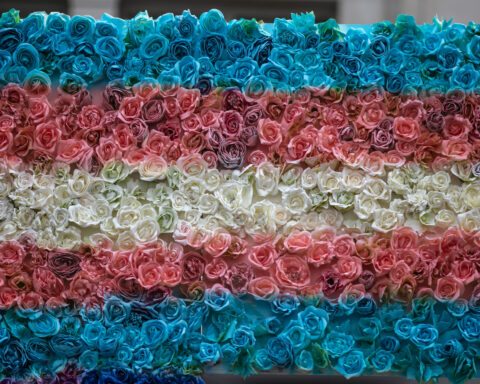Among the obsessions of Christian Nationalist circles today, the infamous question of Pontius Pilate arguably looms largest: What is truth? I was curious to know, too, so I posed the question to two very different picture books.
Both works are aimed not at children but at adults. The first, titled Johnny the Walrus and written by transphobic conservative talking head Matt Walsh, just crested its second anniversary. The second, The Mysteries, was created in a collaboration between Calvin and Hobbes cartoonist Bill Watterson and caricaturist John Kascht and released last October. Notably, The Mysteries is Bill Watterson’s first book since his strip Calvin and Hobbes ended in 1995. It has an unrelated, much darker storyline and a strikingly different art style. Moving between Johnny the Walrus and The Mysteries, I will examine the fascinating treatments of the themes of truth and authenticity in each of these cultural artifacts.
Johnny the Walrus is one of those conservative picture books marketed to parents who follow the work of right-wing commentators. Self-described “theocratic fascist” Matt Walsh published it to satirize “transgenderism” through a story of a little boy who spontaneously announces to his family that he is a walrus. His mother takes him to a liberal doctor, who says that she needs to affirm this fantasy wholesale. In the end, Johnny stops playing and returns to being a boy. Johnny the Walrus is yet another tired version of the transphobic “I identify as an attack helicopter” joke, which was ubiquitous over the last few years in conservative comedy. This book adds the moral that ‘kids will identify as anything’, so we adults should not take them too seriously if they come out as trans.
Johnny the Walrus is unoriginal, concerned with throwing off the so-called cultural lie that we construct identities socially. Walsh wants us to return to tradition’s brute facts, which were supposedly always identified with objective truth. Because Walsh is a fellow Christian, I know this rhetorical obsession with objective truth also roots back to a desire for the Christian God’s existence to be objectively verifiable. For many, anything less means our religious institutions can be nothing but elaborate games. And who has time for games when souls are on the line?
The Mysteries opposes Johnny‘s flat, colorful art style (which deceptively mimics a picture book for children) via a world made from something that feels timelessly old. With rich charcoaly wisps and characters bearing grotesquely textured features, its punch-line waits till the end. The Mysteries follows a kingdom that lives in fear of neighboring wild entities called Mysteries until a group of Knights decides to capture them and bring them back in cages. When they present the Mysteries before the townspeople and King, everyone is shocked by how ordinary and mundane each Mystery is. Life goes on after the Mysteries, and as eons go by, people stop looking. Just as apocalyptic signs reminiscent of climate collapse start to intrude, the story zooms out to the cosmos, indifferent to the people and their struggles. Here, in the void of Outer Space, the Mysteries live on, peacefully undisturbed.
The Mysteries paints a more sophisticated picture than Johnny in a few ways. Watterson invites us to assume first the narrower, time-bound viewpoint of the humans and then pull back to experience the perspective of the quasi-Eldritch entities of the Mysteries themselves. Truth is not fixed in firm axioms here, either. Not only is it contextual to perspectives and resistant to human-centered ways of knowing, but it finds its very basis in unknowability. Sure, I read it as a cheeky, playful commentary on metaphysics, but it also has something interesting to say about identity, in contrast to the Walshian perspective. And yes, it’s trans. Allow me to elaborate.
Something I get tired of as a trans person, from both conservatives like Walsh and many establishment Liberals, is a rhetorical obsession with authenticity. On the one hand, we have the conservative authenticity-as-domination, which tells trans folk we will never be real. On the other hand, liberals and progressives usually traffic in authenticity-as-telos, seeing transition as moving towards an alignment on the horizon that will finally make trans folks normal. The problem is that authenticity tends to imply that transition reveals something always true for us, always there. This narrative holds that the suspicious-detective mentality of conversion therapy (Asking what traumas and experiences made you trans or queer) is valid if we find the perfect set of characteristics for determining who gets included and who is out. But transqueer people know that there will always be outliers to any rule and that while many do use “authentic self” language, many trans people do not describe their journeys in this way.
As long as identity discourse centers the idol of authenticity, we will always see it used to police those who exist on the fringe of the reified schema it implies. In other words, we usually set up a regime for establishing and verifying authenticity not to protect who is real but to police and cage the Mysteries of our worlds. Solidarity against the machines that seek to weaponize authenticity and identity against us should stem from the reality that we all contain Mystery in and around our deepest selves. Today, as hundreds of anti-trans legislative bills nationwide demonstrate, the Margins is still a category that includes trans people. We will not move past marginalization by passing the buck to other minorities once the system finally understands how to fit us into its boxes. Moving from cages to boxes is never liberation. Nowadays, seeming authentic is also profitable. There are cultural cues skilled performers can tap if they want to tug on a heartstring or jerk a tear. This mainstream paradigm of authenticity is ultimately built around a ritualized spectacle that caters to cis expectations.
Authenticity also says all trans people transition through shedding what feels inauthentic so we can fit a new (stable, contained) label that works for us. However, I experience my transition not as sculpture down to a core self but as painting–additive. I do not see myself as having been the same way from the beginning. I contain cumulative multitudes, and I am every me I have ever been at once. I unfold, and the plot thickens–and in a community that understands things in this way, I have permission to change my mind according to what I need in a given moment. A sculpture framing can often offer clarification and relinquishment, and it is not bad–it just should not be a requirement for validation.
In the book You and Your Profile by Hans-Georg Moeller and Paul J. D’Ambrosio, the authors liken the dominant Western notion of authenticity to a peach pit view of the self, whereas ‘Genuine Pretending’ is more of an onion-shaped understanding. As Kendrick Lamar asks in his song N95, we might ask: what remains after we have “taken it all off”? Moeller and D’Ambrosio would respond, Nothing. Authenticity promises an unchanging core self, while Genuine Pretending leaves only a void beneath the last layer–one that enables any play that brings a sense of integrity to our relationships. I reformulate their ‘Nothing’ as a ‘No-Thing’, because the Image of God, what Quakers call ‘that of God within us’ is not exactly a ‘thing’. God is before and beyond all things. Gender, for me, is a generative, additive gift we give to each other out of our No-Thing–same as faith and same as love. While we unpack conceptualizations of selfhood, identity, and religion, the Creative No-Thing found at the foundations pushes us to re-birth our preconceived notions. This No-Thing is not careless, self-sufficient nihilism. This No-Thing is mutual recognition with the divine excess of understanding–that which waits after the wind, earthquake, and fire within gentle whispers. The abyss stares back, urging a leap of faith and inviting a personal relationship. And this is how I view my trans identity, as well as my faith.
Rather than viewing this approach as disenchanting, I see it as a re-enchantment of reality. Matt Walsh and his ilk require reality to be a peach pit–what the scholar James Carse would call a “finite game”–but Watterson and Kascht show us that the Mysteries still hold the void once we have unpeeled the onion of truth. We are the mutual creation of our creator and the created world within an infinite game of Calvinball.
In the final strip of the Calvin and Hobbes series, the eponymous duo ventures excitedly into a scene of a snow-covered plateau. Watterson draws the background with minimal black lines on what would otherwise be a blank sheet of paper.
Calvin: “Wow, it really snowed last night! Isn’t it wonderful?”
Hobbes: “Everything familiar has disappeared! The world looks brand new!… It’s like having a big white sheet of paper to draw on!”
As they mount their sled and take off down a hill, Calvin returns:
“It’s a magical world. Hobbes, ol’ buddy…Let’s go exploring!”

jules leslie webb (they/she) is a writer, artist, and organizer from a small town Northeast Indiana and is currently based in Nashville, TN. A Faith and Social Justice student at Belmont University in the Class of 2025, Jules explores the intersections between Christian theology, anti-fascist/anarchist movements, and transqueer perspectives through comics.
To them, “anarchism is about reexamining and co-creating social relationships by composting systemically oppressive hierarchies and generating beautiful new forms of horizontal power in the shadow of Empire.”
Their ongoing organizing work relates heavily to the intersection of ecology, decolonization, and abolition. You can find them on Instagram @open_eyes_comics.




Unbound Social